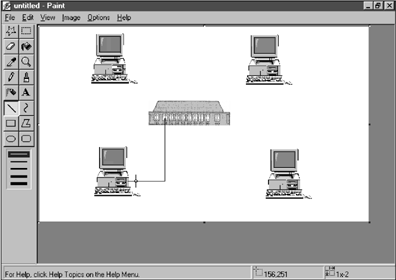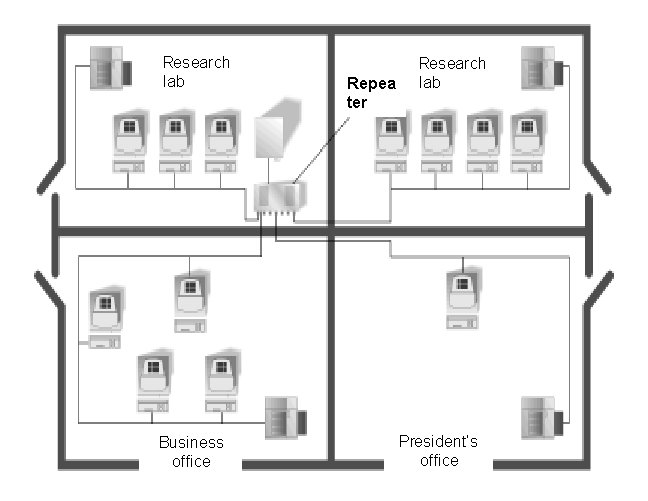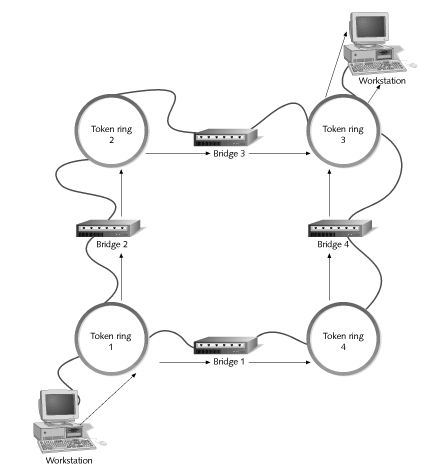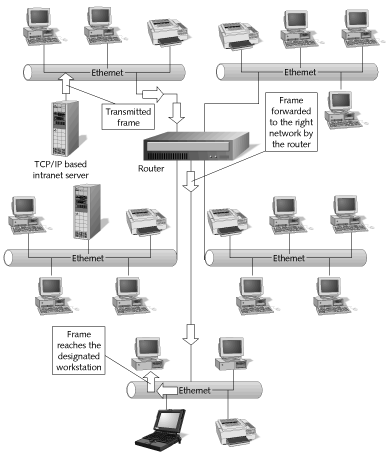Devices for Network and Internetwork
Connectivity
Learning
Objectives
|
- Explain the function of commonly used network
devices such as MAUs, multiplexers, repeaters,
bridges, routers, brouters, hubs, and gateways
- Determine when and how to use those devices
- Describe what OSI layer(s) correspond to the
function of each device
- Explain the function of ATM switching
- Describe how VLANs are an important tool for
managing large networks
|
Multistation Access Units (MAUs)
- Used exclusively on token ring networks, MAUs can perform
the following tasks:
- Connect workstations in a logical ring through a
physical star topology
- Move the token and packets around the ring
- Amplify data signals
- Connect in a daisy-chained manner to expand a token
ring network
- Provide orderly movement of data)
- A passive hub connects nodes in a star topology,
performing no signal enhancement as the packet moves from
one node to the next through the hub.
- An active hub connects nodes in a star topology,
regenerating, retiming, and amplifying the data signal
each time it passes through the hub.
Multiplexers
- Multiplexers are network devices that can receive
multiple inputs and transmit them to a shared network
medium.
- Multiplexers simply are switches used in old and new
technology, such as the following:
- Telephone switching
- Switching telecommunications lines to create multiple
channels on a single line.
- Serial communications to enable more than one
terminal to communicate over a single line.
- Fast Ethernet, X.25, ISDN, frame relay, ATM, and
other networking technologies to create multiple
communication channels over a single communications
cable.
- A multiplexer is a switch that divides a communication
medium into multiple channels so several nodes can
communicate at the same time.
- A signal that is multiplexed must be demultiplexed at the
other end.
- Work at the OSI physical level, switching from channel to
channel using one of three physical methods:
- Time division multiple access (TDMA)
- Frequency division multiple access (FDMA)
- Statistical multiple access
- TDMA enables multiple devices to communicate over the
same communications medium by creating time slots in
which each device transmits.
- TDMA divides the channels into distinct time slots.
Each time slot is designated for a particular network
node, as if it were a dedicated line.
- TDMA does not guarantee the most efficient use of the
network medium, since transmission occurs on only one
channel at a time.
- The timing of node transmission is also important,
because a node may transmit at an interval that is
out of synchronization with its time slot.
- FDMA creates separate channels on one communication
medium by establishing different frequencies for each
channel.
- FDMA divides the channels into frequencies instead of
time slots.
- Each channel has its own broadcast frequency and
bandwidth.
- Statistical multiple access multiplexing allocates
the communication resources according to what is
needed for the task.
- Is used by X.25, ISDN, and frame relay.
- This method is more efficient than TDMA or FDMA,
because the physical medium bandwidth is dynamically
allocated based on the application need.
- The multiplexer continuously monitors each channel to
determine the communication requirements.
Repeaters
- A repeater amplifies and retimes a packet-carrying signal
so it can be sent along all cable segments.
- As used in this context, a segment of cable is one cable
run within the IEEE specifications.
- How repeaters are used:
- To extend a cable segment
- To increase the number of nodes beyond the limit of
one segment
- To sense a problem and shut down a cable segment
- To amplify and retime a signal (as a component in
other network devices)
- When a repeater retransmits a signal along more than one
additional cable segment, it is called a multiport
repeater.
- An attached unit interface (AUI) connects coax or
fiber-optic backbone cable to a network node, such as a
repeater.
- A partitioned segment is one that has been shut down
because a portion of the segment is malfunctioning.
Bridges
- A bridge is a network device that connects different LAN
segments using the same access method.
- Bridges are used to:
- To extend a LAN when the maximum connection limit has
been reached
- To extend a LAN beyond the length limit
- To segment LANs to reduce data traffic bottlenecks
- To prevent unauthorized access to LAN (for security)
- The first bridges were developed by DEC in the early
1980s. DEC’s work on bridges was incorporated in the
IEEE 902.1 standard.
- A network device that operates in promiscuous mode reads
frame destination address information before sending a
packet onto other connected segments of the network.
- A local bridge connects networks in close proximity and
is used to segment a portion of a network to reduce
problems caused by heavy traffic.
- A remote bridge joins networks across the same city,
between cities, and between states to create one network.
Token Ring Bridging
- Token ring bridges use source routing to forward packets
on the network.
- Originally proposed by IBM, source-route bridging has
been incorporated into the 802.5 token ring LAN
specification.
- When a node anticipates sending a packet on a bridged
network, it issues an explorer packet. Each bride that
receives the explorer packet copies it onto all outbound
ports. Route information is appended to the data area of
the explorer packets as they travel through the
inter-network.
- When the sending node’s explorer packets are
received by the destination node, the destination node
replies to the sending node using the accumulated route
information. Then the sending node must select a path to
the destination node.
- The path is determined by three factors:
- the route taken by the first packet received back
- the minimum number of hops to the destination
- the path that will enable the largest packet size.
- Hops are the number of times a packet travels
point-to-point from one network to the next.
Routers
- Routers can connect networks that have dissimilar data
links.
- It forwards packets to networks by using a
decision-making process based on:
- Routing table data
- Discovery of the most efficient routes
- Preprogrammed information from the network
administrator
- To efficiently direct packets from one network to
another, reducing excessive traffic
- To join neighboring or distant networks
- To connect dissimilar networks
- To prevent network bottlenecks by isolating portions
of a network
- To secure portions of a network from intruders
- A router forwarding a frame to the right network:
- When equipped with the appropriate hardware and software,
routers can connect to the following networks, among
others:
- Nodes regularly communicate with a router to confirm
their address and presence.
- Routers are designed to send packets along paths with the
lowest volume of traffic and with the lowest cost in
terms of using network resources.
- As a network grows in complexity, the need to ship
packets along the shortest, most efficient path grows
proportionally. Bridges often are replaced by routers to
ensure that growing network traffic is handled
efficiently and network congestion avoided.
- Static and dynamic routing:
- Static routing involves control of routing decisions
by the network administrator through preset routing
instructions.
- In dynamic routing, the router constantly:
- Checks the network configuration
- Automatically updates routing tables
- Makes its own decisions about how to route frames
Routing Tables and Protocols
- Routers maintain information about node addresses and
network status in databases.
- The routing table database contains the addresses of
other routers and each end node.
- Routers regularly exchange information about network
traffic, the network topology, and the status of network
lines.
- Routers exchange information by using one or more routing
protocols.
- Local and Remote routers:
- A local router joins networks in the same building or
between buildings in close proximity.
- A firewall is software and/or hardware employed to
restrict who has access to a network, to specific
network segments, or to certain network resources
(such as servers).
- A remote router joins networks across large
geographical areas, such as between cities, states,
and countries.
Brouter
- A brouter, also called a multiprotocol router, is a
network device that acts like a bridge or a router,
depending on how it is set up to forward a given
protocol.
- It is used on networks that operate with several
different protocols.
- Brouters are used to:
- For efficient packet handling on a multiprotocol
network with some protocols that can be routed and
some that cannot
- To isolate and direct network traffic to reduce
congestion
- To join networks
- To secure a certain portion of a network by
controlling who can access it
- A brouter is used on networks that operate with several
different protocols, such as:
- Also called a multiprotocol router.
- Whether it bridges or routes a protocol can depend on
these things:
- The instructions programmed in by the network
administrator for handling a protocol
- If the incoming frame contains routing information
- When a brouter is set to forward but not route a
protocol, it forwards each frame using addressing
information in the MAC sub-layer of the data link layer,
just like a bridge.
- That capability is important on a network when one of the
protocols is NetBEUI, which cannot be routed.
Hubs
- A hub is a central network device that connects network
devices in a star topology.
- Advanced hubs provide very high speed connectivity for
FDDI, Fast Ethernet, frame relay, and ATM networks.
- It is also referred to as a concentrator (or switch),
which is a device that can have multiple inputs and
outputs all active at one time.
- Services offered by hubs:
- Provide a central unit from which to connect multiple
nodes into one network
- Permit large numbers of computers to be connected on
single or multiple LANs
- Reduce network congestion through centralizing
network design
- Provide multiprotocol services, such as
Ethernet-to-FDDI connectivity
- Consolidate the network backbone
- Enable high-speed communications
- Provide connections for several different media types
- Enable centralized network management
- MAUs
- 10BASE-T hubs
- 100BASE-X hubs
- Intelligent and modular hubs
10-Base-T Hubs
- One of the simplest hubs
- Popular way to connect workgroups on small and large LANs
- Uses physical star topology to connect PCs to the central
hub
- Additional hubs are added by connecting one hub to the
next.
Switching Hubs
- Permit significant increase in the throughput capability
of an existing 4 Mbps, 10 Mbps, or 16 Mbps network by
taking full advantage of exiting bandwidth capabilities
- Allow an existing network to be separated into multiple
smaller segments, each independent of the others
- Can be installed on LANs in a WAN where specific LANs are
experiencing increased network traffic.
100-Base-X Hubs
- Multimedia, video, and GUI client/server applications
have fostered the need for high-bandwidth, high-speed
technologies.
Intelligent and Modular Hubs
- An intelligent hub has network management and performance
monitoring capabilities.
- A modular hub, also called a chassis hub, contains a
backplane into which different modules can be inserted.
- A backplane is the main circuit board in modular
equipment, containing slots as plug-ins for modular
cards. It provides connections between the modular
boards, a power source, and grounding.
Diagram of a 10-Base-T Star Topology on Two Floors
- Network diagram of 10BASE-T network segments
connected to an intelligent hub
|
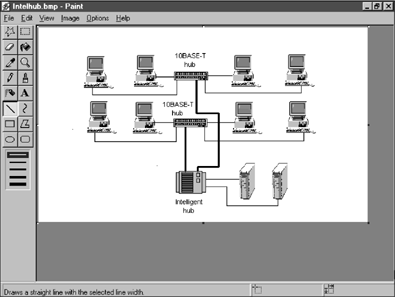 |
Gateways
- A gateway enables communications between two different
types of networked systems, such as between complex
protocols or between different e-mail systems.
- How gateways are used:
- To convert commonly used protocols to a specialized
protocol
- To convert message formats from one format to another
- To translate different addressing schemes
- To link a host computer to a LAN
- To provide terminal emulation for connections to a
host computer
- To direct e-mail to the right network destination
- To connect networks with different architectures
- Systems Network Architecture (SNA) SNA is
a layered communications protocol used by IBM for
communications between IBM mainframe computers
and terminals.
- It employs seven-layered communications that are
similar to the OSI model, but there are
differences in the way the services are grouped
within the layers.
|
 |
ATM Switches
- An ATM switch determines the network channel used to
transmit an ATM cell received from a node, taking into
account the type of information in the cell (voice,
video, data) and the transmission speed needed.
- Capabilities of ATM switches:
- Provide high-speed communications on a network
backbone
- Provide cell transmissions directly to the desktop
- Enable high-speed communication between network hubs
- Centralize network design for better management
- Connect to very high speed networks, such as SONET
- Enable network design around workgroup members at
dissimilar locations (virtual LANs)
- Reduce network bottlenecks through high-speed
communications and efficient traffic management
through workgroups
| ATM Switch 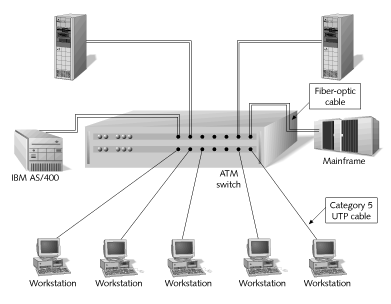
|
Virtual LANs (VLANs)
- A virtual LAN (VLAN) uses switches, routers, and
internetworking software to configure a network into
sub-networks of logical workgroups, independent of the
physical network topology.
- Advantages of VLANs:
- VLANs enable a network to operate at the most
efficient level; it is not limited by physical
topology.
- Network resources can be managed based on the actual
work groupings of users.
- VLANs can be reconfigured to move a user from an old
workgroup to new one.
Networking Devices and the OSI Model
| OSI Layer |
Network Device |
| Application |
Gateways |
| Presentation |
Gateways |
| Session |
Gateways |
| Transport |
Gateways |
| Network |
Gateways, routers, source-route bridges,
brouters, ATM switches |
| Data link |
MAUs, intelligent hubs, bridges, gateways,
brouters, ATM switches |
| Physical |
MAUs, multiplexers, passive and active hubs,
repeaters, gateways |
